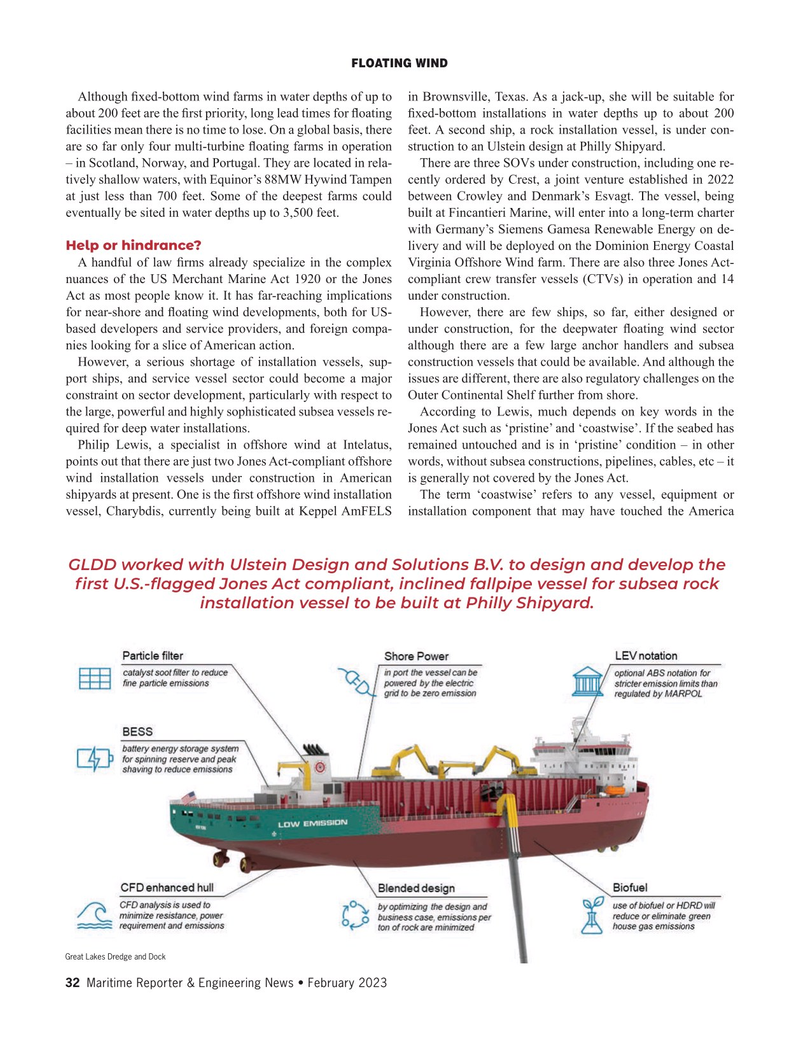
Page 32: of Maritime Reporter Magazine (February 2023)
Government Shipbuilding
Read this page in Pdf, Flash or Html5 edition of February 2023 Maritime Reporter Magazine
FLOATING WIND
Although ? xed-bottom wind farms in water depths of up to in Brownsville, Texas. As a jack-up, she will be suitable for about 200 feet are the ? rst priority, long lead times for ? oating ? xed-bottom installations in water depths up to about 200 facilities mean there is no time to lose. On a global basis, there feet. A second ship, a rock installation vessel, is under con- are so far only four multi-turbine ? oating farms in operation struction to an Ulstein design at Philly Shipyard. – in Scotland, Norway, and Portugal. They are located in rela- There are three SOVs under construction, including one re- tively shallow waters, with Equinor’s 88MW Hywind Tampen cently ordered by Crest, a joint venture established in 2022 at just less than 700 feet. Some of the deepest farms could between Crowley and Denmark’s Esvagt. The vessel, being eventually be sited in water depths up to 3,500 feet. built at Fincantieri Marine, will enter into a long-term charter with Germany’s Siemens Gamesa Renewable Energy on de-
Help or hindrance? livery and will be deployed on the Dominion Energy Coastal
A handful of law ? rms already specialize in the complex Virginia Offshore Wind farm. There are also three Jones Act- nuances of the US Merchant Marine Act 1920 or the Jones compliant crew transfer vessels (CTVs) in operation and 14
Act as most people know it. It has far-reaching implications under construction. for near-shore and ? oating wind developments, both for US- However, there are few ships, so far, either designed or based developers and service providers, and foreign compa- under construction, for the deepwater ? oating wind sector nies looking for a slice of American action. although there are a few large anchor handlers and subsea
However, a serious shortage of installation vessels, sup- construction vessels that could be available. And although the port ships, and service vessel sector could become a major issues are different, there are also regulatory challenges on the constraint on sector development, particularly with respect to Outer Continental Shelf further from shore.
the large, powerful and highly sophisticated subsea vessels re- According to Lewis, much depends on key words in the quired for deep water installations. Jones Act such as ‘pristine’ and ‘coastwise’. If the seabed has
Philip Lewis, a specialist in offshore wind at Intelatus, remained untouched and is in ‘pristine’ condition – in other points out that there are just two Jones Act-compliant offshore words, without subsea constructions, pipelines, cables, etc – it wind installation vessels under construction in American is generally not covered by the Jones Act. shipyards at present. One is the ? rst offshore wind installation The term ‘coastwise’ refers to any vessel, equipment or vessel, Charybdis, currently being built at Keppel AmFELS installation component that may have touched the America
GLDD worked with Ulstein Design and Solutions B.V. to design and develop the ? rst U.S.-? agged Jones Act compliant, inclined fallpipe vessel for subsea rock installation vessel to be built at Philly Shipyard.
Great Lakes Dredge and Dock 32 Maritime Reporter & Engineering News • February 2023
MR #2 (18-33).indd 32 2/1/2023 3:46:28 PM

 31
31

 33
33
